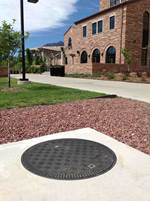Composite manhole covers
UK utility trials ultralight access covers to reduce worker injuries and resulting compensation claims
Back injuries caused by lifting and moving traditional metal or concrete manhole covers is a real health concern that costs utilities everywhere significant worker compensation claims. Indeed, a fact sheet issued by the League of Minnesota Cities in the US says that less than 10% of the US male population has the physical ability to manually move a manhole cover safely. Facing similar concerns, United Utilities’ cover and frame manager Sammy Nelson contacted Structural Science Composites Co. (SSC, Barrow in Furness, UK), which has designed and manufactured composite manhole covers for 10 years, to participate in an extended trial program to evaluate the benefits of switching to composite access covers, to replace conventional ductile-iron or steel-and-concrete covers.
SSC supplied its patented and trademarked Thrubeam cover design. It combines a proprietary, prefabricated dry fiberglass reinforcement, which incorporates composite stiffening “beams,” with a specially developed Crestapol acrylic resin from Scott Bader Company Ltd. (Wollaston, Northamptonshire, U.K.) in a resin transfer molding (RTM) process. The molded covers exhibit high strength-to-weight and the typical surface details and required anti-slip finish. The composite covers are corrosion-resistant, nonconductive, and eliminate theft for scrap value, which is a real issue with metal covers. Thrubeam covers also meet British Standard BS EN124:1994 Group 4 Class D400, which specifies that an access cover must withstand a 40-MT static test load.
Says Nelson, “SSC’s composite covers can be as little as one-third the weight of a ductile-iron cover, and as much as 80% lighter than a steel-and-concrete cover. In addition they provide a superior anti-skid surface, are lockable, and do not corrode; they also look great in ground.” The biggest benefit? “There has been a huge reduction in the risk of back injury for United Utilities inspection teams and installation contractors, in that the covers can be moved by one person when installed, using the SSC ergonomically designed lifting tool,” concludes Nelson.
Related Content
-
Bio-based, fire-resistant composites become mainstream
Projects use Duplicor prepreg panels with highest Euroclass B fire performance without fire retardants for reduced weight, CO2 footprint in sustainable yet affordable roofs, high-rise façades and modular housing.
-
Sustainable Infrastructure Systems creates fiber-reinforced post-consumer plastic structural panels
Australian composites manufacturer offers a scalable building solution, already established in a pedestrian bridge application, to tackle unprocessed soft plastics waste.
-
CirculinQ: Glass fiber, recycled plastic turn paving into climate solutions
Durable, modular paving system from recycled composite filters, collects, infiltrates stormwater to reduce flooding and recharge local aquifers.















